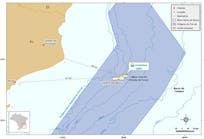Statoil fails to find oil in Arctic’s Hoop program
Statoil ASA has wrapped up its 2014 exploration program in the Hoop area of the Norwegian Barents Sea, northeast of Johan Castberg, without making any commercial discoveries.
Three exploration wells—the Atlantis and Apollo in PL615 and Mercury in PL614—were drilled during the summer, with Atlantis and Mercury resulting in two small gas discoveries.
Statoil says it proved a good reservoir in Apollo, where, notably, the Statoil-contracted Spitsbergen drilling rig was boarded May 26 by members of the environmental activist group Greenpeace (OGJ Online, May 27, 2014). However, no hydrocarbons were encountered at the prospect.
“We are naturally disappointed with the results of this summer’s drilling campaign in the Hoop area,” commented Irene Rummelhoff, Statoil senior vice-president for exploration on the Norway continental shelf.
“However, it is important to understand that Hoop is a frontier area of more than 15,000 sq km with only six wells completed to date, so we do not have all the answers about the subsurface yet. Noncommercial discoveries and dry wells are part of the game in frontier exploration. They provide important knowledge about the area.”
The prospects selected for the campaign tested different play models in varied geological settings and at different depths.
“We will now analyze the data we have acquired in the wells and incorporate it in our subsurface models,” said Rummelhoff. “We have confirmed a working petroleum system in Hoop, but need to work further to understand the migration and where the oil has accumulated. We know from experience that exploring for hydrocarbons in the Barents Sea takes time and stamina.”
In the Hoop area’s neighboring PL537 license, Statoil is partner in the OMV (Norge) AS-operated oil discoveries Wisting Central, the Barents Sea’s northernmost oil discovery estimated to hold 60-160 million bbl of recoverable oil and 10-40 bcf of recoverable gas (OGJ Online, Sept. 6, 2013); and Hanssen, estimated to hold 20-50 million boe, most of which is oil (OGJ Online, July 3, 2014).
